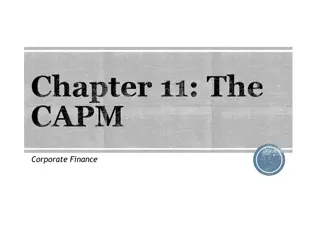
Challenges Faced by Diverse Candidates in Leadership Positions
Exploring the struggles of diverse candidates, particularly African-American women, in attaining top leadership roles in corporate settings dominated by Caucasian males. The study delves into how physical and behavioral similarities among Caucasian males provide them with advantages in career progression, mentorship opportunities, and income differentials. The research underscores the disparities in resources, opportunities, and appraisals faced by individuals of different races and genders, shedding light on the inherent biases in professional environments.
Download Presentation

Please find below an Image/Link to download the presentation.
The content on the website is provided AS IS for your information and personal use only. It may not be sold, licensed, or shared on other websites without obtaining consent from the author. If you encounter any issues during the download, it is possible that the publisher has removed the file from their server.
You are allowed to download the files provided on this website for personal or commercial use, subject to the condition that they are used lawfully. All files are the property of their respective owners.
The content on the website is provided AS IS for your information and personal use only. It may not be sold, licensed, or shared on other websites without obtaining consent from the author.
E N D
Presentation Transcript
Portfolio Project Joi Ford SOSC301 Dr. Dan Barrett
Purpose for Study Diversity in the workplace has been a challenge for many employers. Although many companies have come a long way in diversifying their talent, there is still a struggle to push that diversity to top leadership positions. As a millennial, closer to the 40 year-old marker, African- American, and a woman, competing for top-level leadership opportunities, it is worth mentioning that the competitors share similar characteristics. Corporate leaders follow that trend and promoting candidates that identify with similar characteristics. Male, Caucasian, older, tall, no beard, and athletically fit. Interpersonal traits align selfishness, arrogance, lack of emotional intelligence, and low disregard for stakeholders. Candidates have a good sense of numbers and task-driven. The purpose of studying the dynamics of Caucasian males is to learn how to relate and coexist in a mutual professional environment. In addition, identify, if any specifics, how Caucasian males applying for leadership roles get leverage over any other culture, gender, and age with the same qualifications and knowledge.
Source Overview My primary source suggests that individuals excel or regress depending upon the advantages and disadvantages of resources, opportunities, appraisals, and deference. Gender, race, and other components are contributors to individuals advantage and disparity for others. An agency does not exist without others, while communion relies on the agency to live out their lives. An agency has leverage in hierarchy professionally, and the disadvantaged individuals lean toward communion. If an agency seeks communion, gaps in disparities will close among the disadvantages of resources, opportunities, appraisals, and deference. (Rucker et al., 2018) The overall finding is that agency seeks greater agency, and the disadvantage seeks more communion. I questioned the behavioral matters of Caucasian males in positions of leadership, physical similarities, and leverage to gain hierarchy in a professional environment. (Rucker et al., 2018) explain that Caucasian men overall have the advantage of resources, opportunities, appraisals, and deference more than any other race, gender, and culture. More advantageous individuals who are more agentic tend to seek more agency and are considered as power-seeking. Agencies seeking greater agency, because of the advantages, can be done consciously or unconsciously. (Rucker et al.,2018) reference (Gaines et al., 1997) suggesting that Caucasians are more agentic than any other race in the United States. (Dreher et al., 1996) gives a report of minorities and Caucasian's participation in mentorship programs but would not pair up with White men. White students would pair up with White mentors. At the end of the study, equally qualified candidates made a significant difference in income. White students that paired with White mentors earned approximately $16,800 dollars than that of minorities that paired with women or minority mentors. (Diaz, 2020) addresses that skin color phases out in the hiring process, however, high social class supersedes skin color.
Research (Dreher et al., 1996) White men have the advantage over women and men of other races because they are more likely to form developmental relationships with individuals who are similar to themselves. These individuals (other White men) will be more fully integrated than female counterparts or male counterparts of other races into networks of influential decision makers. Therefore, they are better able to promote the career interests of newcomers. A study was conducting looking at mentorship as a means for development and providing psychosocial support and how race and sex affect a group of MBA s career success. Lack of diversity provide difficulties for some to reach their full potential, whereas many needed to find mentors who were much like themselves for support and executives at that time were limited if the leaders were non-white or women. Cross pairing a non-white intern or woman intern with a Caucasian and male mentor in many cases did not go over well because of the acquired feeling of being inferior under the mentor. Caucasian interns with Caucasian mentors were best matched while their prot g experienced better career success rather any other match. (Diaz, 2020) Reports a study that investigated hiring possibilities for based on skin color in Brazil and relevant to US research whereas skin color and race could be used interchangeably. His finding support his theory that people with darker skin tones have least opportunity when applying administrative and sales roles. In terms of gender men dominated over women, however lighter skin color for women would be more favorable over gender. Skin color is also linked to higher ranking social class, in which the assumption of better education and general background. Although an association between skin color and a range of socioeconomic outcomes exists, scholars are unclear about the root causes of skin color inequality. Prior research has suggested that skin color inequality can be explained by two factors: the legacies of past discrimination and contemporary discrimination. The first perspective asserts that individuals with light skin experienced privilege (usually measured by higher levels of education, income, 3 and wealth) due to their proximity to whiteness .
Social class is associated with the advantages of knowledge, experience level, and preference for higher process over skin color. Disadvantages and advantages affect individuals ability to seek hierarchy in professional roles. Disadvantages and advantages affect people social skills and behaviors. Discrimination and stigmas still exist with skin color. There is a social sense of belonging. Humans identify with people who are much like them given a dominant Caucasian male preference in a company non-Whites and women experience high competition for leadership roles.
Cultural Awareness More research is needed to conclude how the culture of Caucasian males drives their success. What is prevalent is that society as a whole needs to embrace change. Fear to socialize with our counterparts that are different from our own culture only limits our understanding, creativity, and ability to progress in every avenue. Educating ourselves, showing empathy, and humility for cultural differences we do not understand can begin to break down barriers so that companies will diversify. Leadership is a competitive role. Leaders seek to make it executive positions have done so because of their characteristics. Men and women can be sincere and empathetic and can lead a company. Women naturally have this skill set more so than men. Men tend to show up more mathematically than women counterparts, not to include that women challenged mathematically. Non-whites tend, be more supportive and building up the community, although this does not exclude them from self-perseverance. Caucasians are more self oriented but not limited to community service or family ties. That is to remind us that we are humans, and our experiences, cultural norms, and experiences shape us into who we are and what type of leaders we can be. Bias thought limits individuals to thrive socially, economically, and professionally. Professional development will require a focus on developing leadership characteristics and abilities to lead. Create an impressive portfolio that outshines being a woman of African American descent but not to shame that I am. Learning contributors to Caucasian men s success; disproves that they are a threat and a part of their competitive culture. Recognize the differences when working with my counterparts, and distinguish malice intent and high stake competition.
Rucker, D. D., Galinsky, A. D., & Magee, J. C. (2018). The AgenticCommunal Model of Advantage and Disadvantage: How Inequality Produces Similarities in the Psychology of Power, Social Class, Gender, and Race. Advances in Experimental Social Psychology, 71 125. https://doi.org/10.1016/bs.aesp.2018.04.001 How skin color, class status, and gender intersect in the labor market: Evidence from a field References experiment. (2020). Research in Social Stratification and Mobility, 65, 100477. https://doi.org/10.1016/j.rssm.2020.100477 Dreher, G. F., & Cox, T. H., Jr. (1996). Race, gender, and opportunity: A study of compensation attainment and the establishment of mentoring relationships. Journal of Applied Psychology, 81(3), 297 308. https://doi.org/10.1037/0021-9010.81.3.297






















